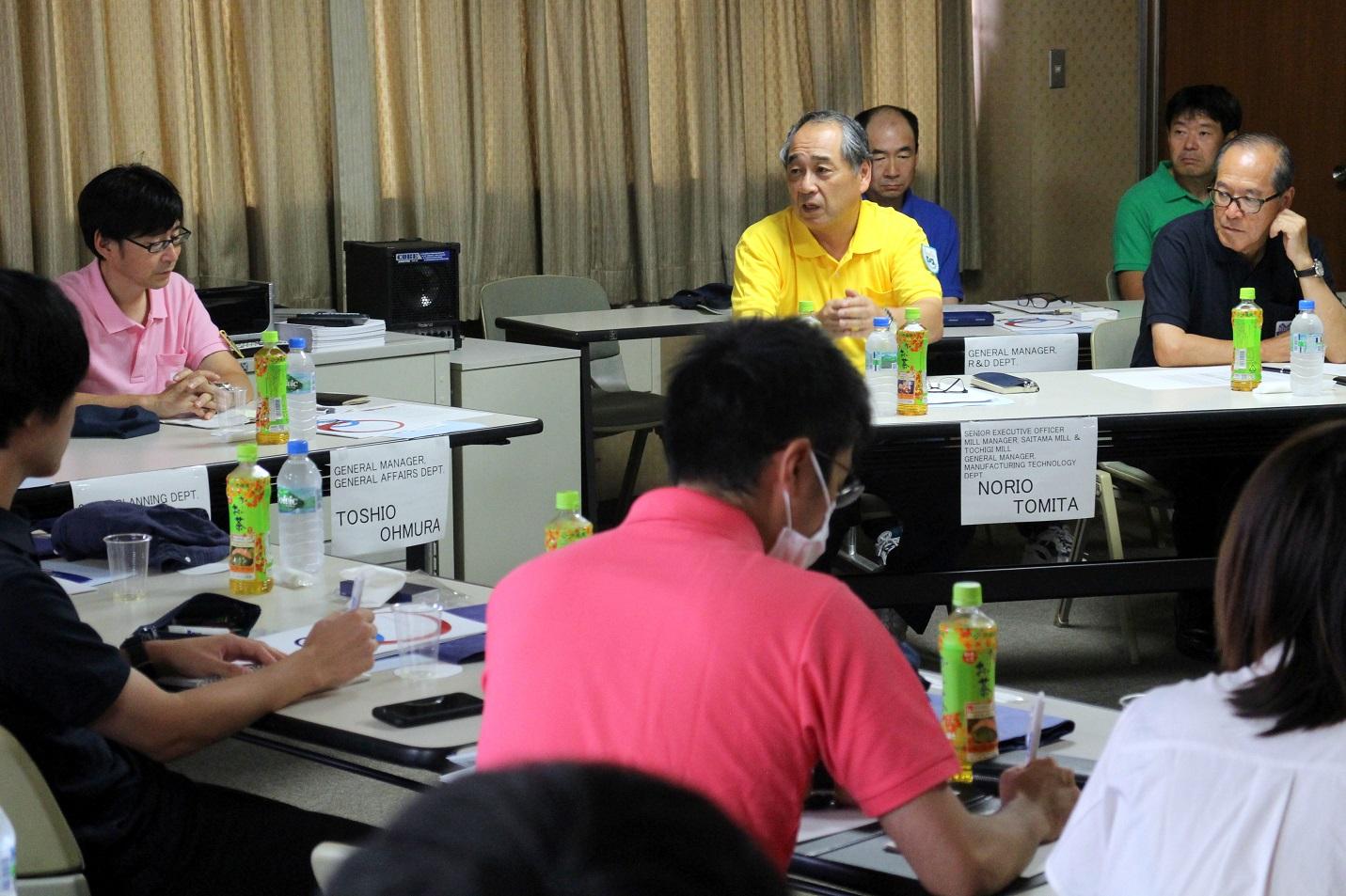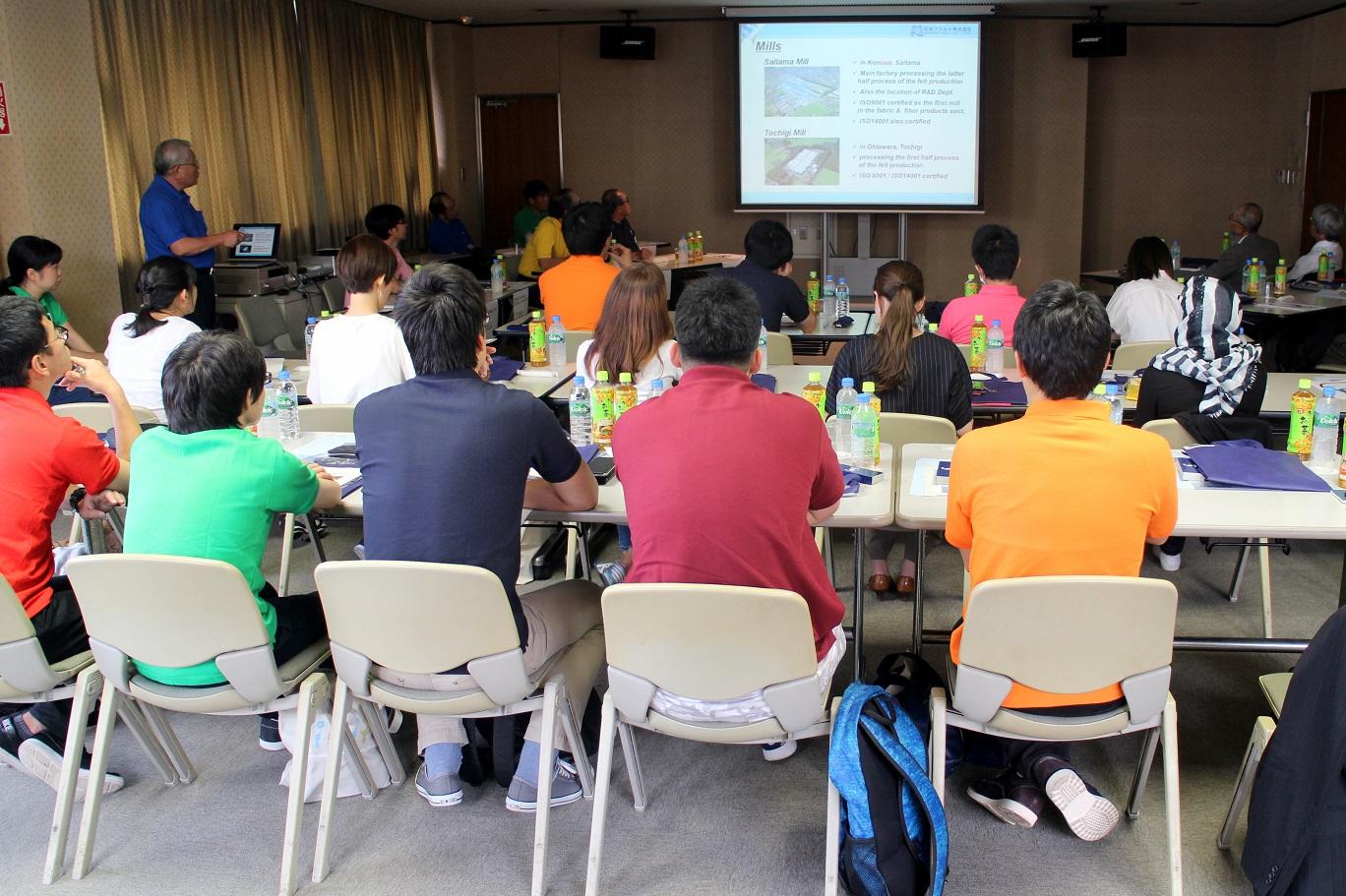Factory Tour at Nippon Felt
On September 5, the Leading Program sent 12 students (10 first-year and 2 second-year students) to the Saitama Plant operated by Nippon Felt Co., Ltd., in the city of Konosu in Saitama Prefecture. The visit, which was a repeat of a similar trip taken by students in 2015, was part of the "Practical Study in Textile Fundamentals" course.
As during that previous visit, Chairman Oyama, who graduated from the Faculty of Textile Science and Technology, led the company's employees in extending a warm welcome to the students.
In addition to the powerful sight of the plant's large machines, the students also saw detailed work performed by human workers to splice together fibers, and they witnessed for themselves how all of the company's employees work together to achieve the goal of manufacturing high-quality products through diligence and hard work. Everywhere tools and supplies were neat and organized, both in and around the company's offices and inside and outside the plant. From this environment, where not even a speck of dust was in evidence, the students were able to learn about the meticulous care and the high level of awareness with which employees approach their jobs.
Chairman Oyama presented the students who participated in the visit with a polo shirt commemorating the 100th anniversary of the company's founding in their choice of any of 18 colors. (Employees wear the same shirt every day at work.) The company even prepared halal box lunches for us, so that one Muslim student had the same lunch with everyone else, and the gesture was reflective of the overall level of hospitality the students were shown, even outside the plant. The Leading Program would like to take this opportunity to express its heartfelt gratitude to Nippon Felt.
[Participation report by James Hirose, 1st-year student]
1. Purpose of participation
For this trip, we visited Nippon Felt, one of the most historical companies in Japan. We will see what makes a company on its feet and maintains a steady growth through an entire century. We will also understand the company's business style by focusing on the work place in the factory.
2. Problems identified as a result of participation
One thing that surprised me the most is how being old-fashion can still be a good thing in a long term. Most big successful companies, in my head, are equipped with the latest high-tech machinery in their research lab, the factory is filled with hard-working automated robot and self-driving carts robustly strolling from one place to another. Nippon Felt is not like that. Based on the font of the printed text, you can tell the machines are clearly over a few decades old, the architecture styles feel it has been a while, and most interesting of all, a lot of live labor working on the production process. For most of the factories we have visited, most workers in its factory were doing task that were highly difficult for robots to do (maintenance work, final check-up, etc...), but for this visit, I saw lines of people sitting down in multiple rows and working on the products by hand, half of dozen people cooperating to properly roll a larger 5-meter-wide paper, or moving around a giant sheet that takes a full dozen.
Of course, most part of the process are automated. I walk through the factory tour, however, thinking whether some process could have been automated or not. It wasn't until the end of tour when we sat down to discuss about the tour where I realized how thick I have been. The whole time I was thinking about producibility and how efficient each process and methods could improve, but I never laid my mind on the finishing product, the quality. In other words, no robot can top the steady hands that make these fine works.
Perhaps I was carried away from my research topic (machine and robotics), and forgotten some importance in proper product making. The company's core motto being "Tradition and new challenges", I feel that I need to remember and know the steps that corporations, projects have taken. Carefully and steadily take the project forward and not to lose yourself in your surrounding and do what is best for where you stand.
3. Results of participation
The mill locates in the middle of a residential district of Saitama prefecture. That is rather amazing considering it is the main factory for paper manufacturing in the whole nation.
A factory that makes paper .The thing that is everywhere we go, it is almost impossible to stay away from in our modern lives.
The amount to produce is, without a question, massive, meaning that the factory is of course very busy, and at the same time, should be very loud.
The machines are kept extremely well to prevent loud vibrations and clashing sounds, and if the giant metal parts still make noises (which is mostly unavoidable) the walls surround it can cut it down to almost nothing. Amazed by this and when I asked the staff at the end of the tour, they explained that they pass all basic standards for environmental restriction, and well beyond the clarifications. This reminded me of one of the other factories we visited earlier this year, where they meet far under of all environmental guidelines the government enforces them to.
Through the many places we have visited, it is certain that companies this successful and steady shows many trait, and one of them being; they don't do what they are told, they do what is right. They never need to be reminded of the obvious.
4. How will you apply what you learned to your research?
I dream the future of prosthetic hands (my research) for being far more advanced from what it is in current day's situation. I believe it can be a lot closer to what we witness in science fiction films (as crazy that might sound). To achieve it, in my thought, is that many of the basic concept of the prosthetic hand should be replaced. As a simple example, instead of reading muscle signals using pads sensors attached to the skin, I believed it is better by implanting a sensor directly from the severed nerves.
After this trip, however, my view has shifted where instead I blow down a wall to achieve the goal, I can always respect the past and bring in the traditions. For the example I mentioned, I can work on finding a solution to improve the current technics.
Groundbreaking research can be exciting for starting brand-new methods to the world, but the world can be built upon on what exists as a stepping stones, brushing up the passed on knowledge to surpass the perfection.

